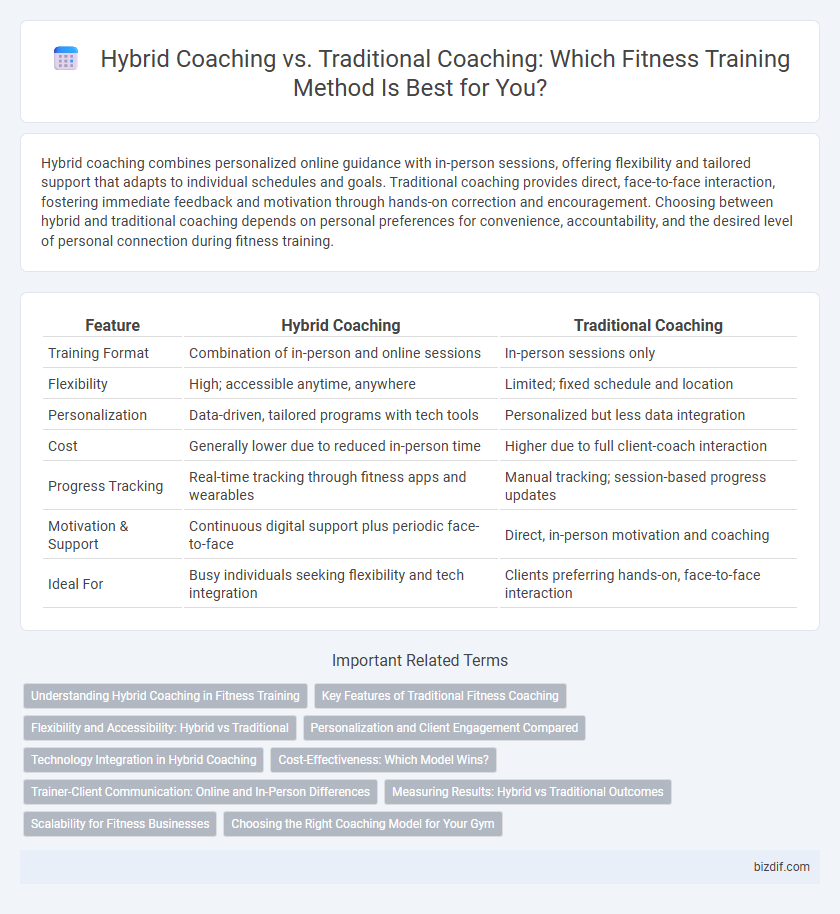Hybrid coaching combines personalized online guidance with in-person sessions, offering flexibility and tailored support that adapts to individual schedules and goals. Traditional coaching provides direct, face-to-face interaction, fostering immediate feedback and motivation through hands-on correction and encouragement. Choosing between hybrid and traditional coaching depends on personal preferences for convenience, accountability, and the desired level of personal connection during fitness training.
Table of Comparison
| Feature | Hybrid Coaching | Traditional Coaching |
|---|---|---|
| Training Format | Combination of in-person and online sessions | In-person sessions only |
| Flexibility | High; accessible anytime, anywhere | Limited; fixed schedule and location |
| Personalization | Data-driven, tailored programs with tech tools | Personalized but less data integration |
| Cost | Generally lower due to reduced in-person time | Higher due to full client-coach interaction |
| Progress Tracking | Real-time tracking through fitness apps and wearables | Manual tracking; session-based progress updates |
| Motivation & Support | Continuous digital support plus periodic face-to-face | Direct, in-person motivation and coaching |
| Ideal For | Busy individuals seeking flexibility and tech integration | Clients preferring hands-on, face-to-face interaction |
Understanding Hybrid Coaching in Fitness Training
Hybrid coaching in fitness training combines in-person sessions with digital guidance, offering personalized workout plans and real-time feedback through apps or video calls. This approach leverages data tracking and technology to enhance motivation and progress monitoring while maintaining the accountability of traditional coaching methods. By integrating flexibility and convenience, hybrid coaching adapts to individual lifestyles, optimizing training efficiency and results.
Key Features of Traditional Fitness Coaching
Traditional fitness coaching emphasizes personalized, one-on-one guidance from a certified trainer, focusing on tailored workout plans and real-time feedback. This method relies heavily on in-person sessions, structured progress tracking, and hands-on technique correction to enhance performance and prevent injury. Key features include scheduled training programs, direct motivation, and accountability through regular face-to-face interaction.
Flexibility and Accessibility: Hybrid vs Traditional
Hybrid coaching offers unmatched flexibility by combining online modules with in-person sessions, allowing clients to customize workout schedules and access training from any location. Traditional coaching often requires fixed appointments and physical presence, limiting accessibility for individuals with busy or unpredictable lifestyles. The hybrid model utilizes digital platforms to provide continuous support and progress tracking, enhancing convenience without sacrificing personalized guidance.
Personalization and Client Engagement Compared
Hybrid coaching delivers personalized fitness programs by combining online tools with in-person guidance, enhancing client engagement through flexible, real-time feedback and progress tracking. Traditional coaching relies on consistent face-to-face interaction, fostering strong personal connections but often lacks the adaptability and data-driven insights available in hybrid models. Clients experience increased motivation and tailored support with hybrid coaching, leveraging technology to optimize workout efficiency and outcomes.
Technology Integration in Hybrid Coaching
Hybrid coaching leverages advanced technology such as AI-driven apps, wearable fitness trackers, and virtual training platforms to provide personalized workout plans and real-time feedback, enhancing client engagement and progress tracking. Unlike traditional coaching, which relies primarily on in-person sessions, hybrid coaching integrates digital tools that enable remote monitoring and adaptive programming based on data analytics. This tech integration allows for more flexible, data-informed fitness strategies that increase accountability and optimize training outcomes.
Cost-Effectiveness: Which Model Wins?
Hybrid coaching combines personalized online guidance with in-person sessions, reducing overall costs by minimizing travel and facility fees. Traditional coaching involves frequent face-to-face interactions, often leading to higher expenses due to hourly rates and gym memberships. Cost-effectiveness analyses reveal hybrid models deliver comparable results at a lower price point, making them an efficient choice for budget-conscious fitness enthusiasts.
Trainer-Client Communication: Online and In-Person Differences
Hybrid coaching combines digital platforms with face-to-face sessions, enhancing trainer-client communication through real-time video feedback and instant messaging, while maintaining personal connection during in-person workouts. Traditional coaching relies solely on physical presence, allowing trainers to assess form and provide immediate, hands-on adjustments, fostering deeper rapport and motivation. Effective communication in hybrid coaching leverages technology to track progress continuously, whereas traditional methods depend on direct observation and verbal cues during scheduled sessions.
Measuring Results: Hybrid vs Traditional Outcomes
Hybrid coaching integrates real-time data tracking and personalized feedback to optimize fitness progress, resulting in more precise measurement of outcomes compared to traditional coaching methods. Traditional coaching often relies on subjective assessments and periodic evaluations, which may miss subtle performance improvements and hinder timely adjustments. By leveraging technology and continuous monitoring, hybrid coaching enhances accuracy in tracking metrics like strength gains, endurance, and body composition changes.
Scalability for Fitness Businesses
Hybrid coaching combines online and in-person training, allowing fitness businesses to scale rapidly by reaching a larger client base without geographical limitations. Traditional coaching relies heavily on direct, face-to-face sessions, making it difficult to scale efficiently due to time and location constraints. Fitness businesses leveraging hybrid coaching can optimize resource allocation and increase revenue through diversified service delivery models.
Choosing the Right Coaching Model for Your Gym
Hybrid coaching combines in-person and online training methods, offering flexibility and personalized routines, while traditional coaching emphasizes hands-on guidance and real-time correction in a gym setting. Selecting the right coaching model depends on your gym's target clientele, available resources, and desired level of engagement. Evaluating factors such as member preferences, trainer expertise, and technology integration ensures an effective fitness training environment tailored to your gym's goals.
Hybrid coaching vs Traditional coaching Infographic

 bizdif.com
bizdif.com